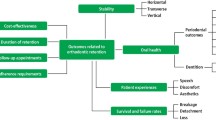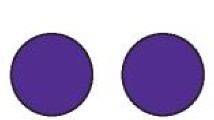Abstract
Data sources
The Cochrane Oral Health Group's Trials Register, the Cochrane Central Register of Controlled Trials (CENTRAL) Medline, Embase, the US National Institutes of Health Trials Register and the World Health Organisation (WHO) Clinical Trials Registry Platform were searched with no restrictions.
Study selection
Randomised controlled trials (RCTs) of orthodontic treatment for posterior crossbites in children and adults were considered.
Data extraction and synthesis
Study selection, data abstraction and risk of bias assessment were carried out independently by two reviewers. Dichotomous data were summarised with risk ratios (RR) and 95% confidence intervals (CIs) and continuous data with mean differences (MD) with 95% CIs. Meta-analyses were conducted when comparisons and outcomes were sufficiently similar.
Results
Fifteen studies were included; seven were at high risk of bias, two at low risk and six at unclear risk. Nine studies compared fixed appliances with mid-palatal expansion but no difference between appliances was reported. Low quality evidence from two studies with 96 participants found that fixed quad-helix appliances may be 20% more likely to correct crossbites than removable expansion plates (RR 1.20; 95% CI 1.04 to 1.37), and quad-helix appliances may achieve 1.15 mm more molar expansion than expansion plates (MD 1.15 mm; 95% CI 0.40 to 1.90;). Very limited evidence showed that both fixed quad-helix appliances and removable expansion plates were superior to composite onlays in terms of crossbite correction, molar and canine expansion.
Conclusions
There is a very small body of low to moderate quality evidence to suggest that the quad-helix appliance may be more successful than removable expansion plates at correcting posterior crossbites and expanding the inter-molar width for children with early mixed dentition (aged eight to 10 years). The remaining evidence we found was of very low quality and was insufficient to allow the conclusion that any one intervention is better than another for any of the outcomes in this review.
Similar content being viewed by others
Commentary
Expansion of the maxillary dentition in order to correct a posterior crossbite is a common orthodontic objective. It can be carried out during the early mixed dentition, usually with the aim of eliminating a concomitant mandibular displacement, or in the full adult dentition.
This Cochrane Review updates one previously carried out by Harrison and Ashby in 2001.1 The review analyses RCTs up to January 2014. The electronic search carried out in this study retrieved 779 references. After screening only l5 studies were included. Of these studies, seven were deemed at high risk of bias, six at an unclear risk and two at low risk.2,3
Data from these two studies were pooled and the results suggested that a fixed quad-helix appliance was more effective in treating posterior crossbites than a removable expansion plate. Both the quad-helix and the expansion plate were better than the use of composite inlays. Interestingly, in one study,3 treatment with the expansion plate was unsuccessful in one third of the subjects.
Orthodontists would also like to know if rapid expansion, as provided typically by a banded/bonded Hyrax appliance, is more effective than the slow expansion produced by a quad-helix or expansion plate.
Unfortunately this review found very few studies available, and the risk of bias was either high or unclear. Rapid palatal expansion is often preferred by orthodontists, as treatment involves opening the mid palatal suture, thus theoretically reducing buccal tipping of the posterior teeth.
The reviewers concluded that current evidence is insufficient to address the question of what is the best treatment for posterior crossbites. The studies included investigated comparisons of a variety of appliances and other forms of treatment and therefore minimal pooling of data was possible. Indeed other important outcome measures, including stability of cross-bite correction, could not be assessed.
As ever, the final conclusion is that more RCTs would be required, not only to investigate the correction of posterior crossbites in children, but also in adolescents and adults. Indeed for orthodontists one of the main outcome measures should be the long-term stability of such interventions.
Practice point
-
Practitioners should check children for the existence of posterior crossbites and, in particular, those with an associated mandibular displacement on closure.
-
Ideally, a full orthodontic diagnosis should be carried out to assess if crossbites are predominantly skeletal or dental in origin, and also to check if there is an underlying digit sucking habit.
-
Quad-helix appliances may be more successful than removable expansion plates in correcting posterior crossbites in children during the mixed dentition.
References
Harrison JE, Ashby D . Orthodontic treatment for posterior crossbites. Cochrane Database Syst Rev 2001; CD000979.
Godoy F, Godoy-Bezerra J, Rosenblatt A . Treatment of posterior crossbite comparing 2 appliances: a community based trial. Am J Orthod Dentofacial Orthop 2011; 139: e45–52.
Petrén S, Bondemark L . Correction of unilateral posterior crossbite in the mixed dentition: a randomized controlled trial. Am J Orthod Dentofacial Orthop 2008; 133: 790. e7–13.
Author information
Authors and Affiliations
Additional information
Address for correspondence: Luisa Fernandez Mauleffinch, Review Group Co-ordinator, Cochrane Oral Health Group, School of Dentistry, The University of Manchester, Coupland III Building, Oxford Road, Manchester, M13 9PL, UK. E-mail: luisa.fernandez@manchester.ac.uk
Agostino P, Ugolini A, Signori A, Silvestrini-Biavati A, Harrison JE, Riley P. Orthodontic treatment for posterior crossbites. Cochrane Database Syst Rev 2014; 8: Art. No. CD000979. DOI: 10.1002/14651858.CD000979.pub2.
This paper is based on a Cochrane Review published in the Cochrane Library 2014, issue 8 (see www.thecochranelibrary.com for information). Cochrane Reviews are regularly updated as new evidence emerges and in response to feedback, and the Cochrane Library should be consulted for the most recent version of the review.
Rights and permissions
About this article
Cite this article
O'Neill, J. Quad-helix appliances may be more successful than removable expansion plates at correcting posterior crossbites. Evid Based Dent 16, 25–26 (2015). https://doi.org/10.1038/sj.ebd.6401083
Published:
Issue Date:
DOI: https://doi.org/10.1038/sj.ebd.6401083



